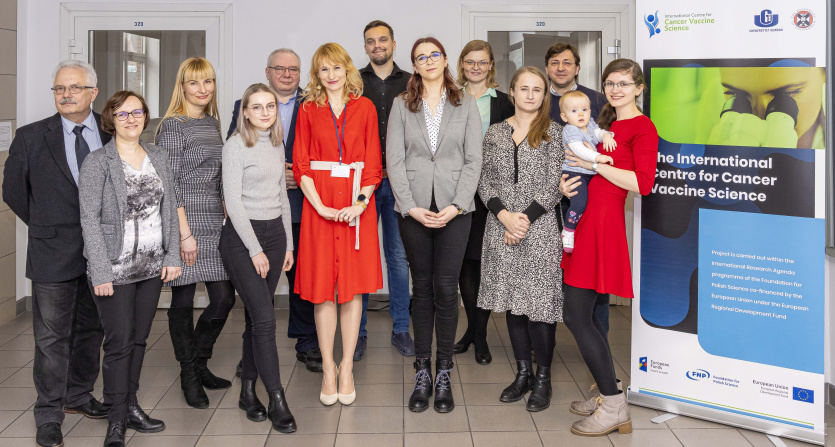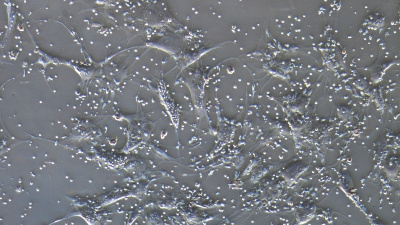Nature Communications published the paper “Mesenchymal stem cells transfer mitochondria to allogeneic Tregs in an HLA-dependent manner improving their immunosuppressive activity”. The publication is a result of collaboration between the researchers from International Centre for Cancer Vaccine Science (ICCVS) University of Gdańsk (UG), Medical University of Gdańsk (MUG), Medical University of Łódź (MU) and PolTREG S.A. The scientists observed that mesenchymal stem cells (MSC) donate their mitochondria to regulatory T cells (Treg). The phenomenon increases significantly the activity of the latest and can be used in the therapy. In addition, observed interactions resulted in joint patent applications of UG, MUG and PolTREG S.A. submitted to the European Patent Office (EPO).
The study conceptualization and coordination was performed by prof. Natalia Marek- Trzonkowska, director of ICCVS, UG. All described experiments have been conducted in Poland and were funded from Polish grants. The paper is a part of doctoral thesis of Karolina Piekarska MSc, whose PhD viva is planned soon.

Na zdjęciu od lewej: prof. Janusz Siebert (Katedra i Zakład Medycyny Rodzinnej GUMed), dr Adriana Schumacher (Katedra i Zakład Farmakologii GUMed), dr Hanna Zielińska (Katera Immunologii Medycznej GUMed), mgr Justyna Sakowska (Katera Immunologii Medycznej GUMed), dr Jan Spodnik (Zakład Anatomii i Neurobiologii GUMed), prof. Natalia Marek- Trzonkowska (ICCVS, UG oraz Zakład Medycyny rodzinnej GUMed), mgr Łukasz Arcimowicz (ICCVS, UG), mgr Karolina Piekarska (Zakład Medycyny rodzinnej GUMed), dr Małgorzata Kurkowiak (ICCVS, UG), dr Iwona Pelikant Małecka (Zakład Medycznej Diagnostyki Laboratoryjnej, GUMed), prof. Piotr Trzonkowski (Katera Immunologii Medycznej GUMed), dr Zuzanna Urban-Wójciuk wraz z najmłodszym członkiem zespołu ICCVS- córeczką Ulą (ICCVS, UG).
Na zdjęciu brakuje 4 autorów: prof. Ted Hupp (ICCVS, UG), prof. Ewa Słomińska (Katedra i Zakład Biochemii GUMed), mgr Bogusław Tymoniuk (Klinika Immunologii i Alergii, UM) oraz prof. Alicja Renkielska (Klinika Chirurgii Plastycznej, GUMed).
Fot. Paweł Sudara/GUMed
Cell based immunotherapies can provide safe and effective treatment for various disorders including autoimmunity, cancer, and excessive proinflammatory events in sepsis or viral infections (including COVID19). However, to achieve this goal there is a need for deep understanding of mechanisms of the intercellular interactions. We need to know what can happen and how the cells may react after administration to patient. Tregs are a unique cell subset in the immune system. In contrary to conventional T cells, they do not fight with bacteria and viruses but suppress activation of the other immune cells. The phenomenon is undesirable in patients with neoplasm. However, Tregs are crucial to prevent us from development of autoimmune diseases and allergies. The cells are also required for induction of immune tolerance to transplanted organs. While MSC are multipotent (they can differentiate into various cell types, for example osteoblasts, glial cells or chondrocytes) nonhematopoietic progenitor cells that are present in human body. One of their rich source is an adipose tissue. Despite of different origin Tregs and MSCs demonstrate immunoregulatory properties that have been already tested in clinical trials (including the trials conducted by the authors of the publication). In the current paper the researchers showed that direct and indirect contact of Tregs with allogeneic (derived from a different donor) MSC potentiates immunosuppressive activity of Tregs. Tregs expanded in presence of MSC are significantly more effective suppressors of conventional T cell proliferation. In addition, they show enhanced degradation of extracellular ATP and AMP, leading to accumulation of tolerogenic adenosine. The phenomenon can be used in therapy of autoimmune diseases (e.g. type 1 diabetes, multiple sclerosis or rheumatoid arthritis) and for induction of tolerance to transplanted organs. If similar interactions take place between autologous cells in tumour microenvironment, then blocking of this communication can became a part of anti-cancer treatment. Thus, the researchers plan to continue the studies in the context of cancer therapy. Nevertheless, the published data uncover much more in terms of intercellular communication. The scientists showed that MSC donate their mitochondria and fragments of plasma membrane to Tregs. If one attempted to compare the cell behaviour to the human world, he/she should imagine organ and skin patches transfer between people who meet directly and shake hands. Moreover, the scientists showed that this phenomenon depends on HLA antigens. HLA molecules are elements of the major histocompatibility complex. Each of us have the unique set of these antigens. This diversity is beneficial from the point of view of evolution and immunity. However, is can became a problem for donor- recipient matching during organ transplantation. The team indicated that the transfer of active mitochondria from MSC to Tregs is more intensive, when HLA mismatches between the cells are more numerous.
“This study shows how a single (initially quite crazy) idea can unexpectedly sprout out and develop multidimensionally”- says prof. Marek- Trzonkowska. “Initially we have been working with Karolina in tandem. These were the days and nights spent in the laboratory. We have often been wondering if our work makes sense or maybe we have already crossed the red line of common sense. I will not forget Karolina’s sight when I decided to froze something extra or collect another set of supernatants. However, when the first proofs appeared and showed that the phenomena that we have just predicted initially, really take place, I have started to ask myself what should I do to make this discovery visible. What is missing in our study? What else should be tested? Nevertheless, through a tangle of circumstances our study sailed soon on deep waters. It was a result of collaboration of scientists from 3 universities, namely Medical University of Gdańsk (MUG), University of Gdańsk (UG, ICCVS), Medical University of Łódź (UM) and PolTREG S.A. company. Working in multidisciplinary team, with people who were curious where the research will lead us and who never asked- what time is it, me manged to publish this study in Nature Communications. How a long way we walked from the laboratory work, through data analysis, figure preparation, discussion with the reviewers, additional experiments…is known only to the co-authors of this study and their families. I am grateful that MSC and Tregs took us for this extraordinary journey and showed us some scenes out of their secret life. I hope that this fascination with the cells will stay forever with me and people who work with me. Curiosity and enthusiasm are simply indispensable in scientific work.”
Those who are interested we direct to the publication:
Karolina Piekarska, Zuzanna Urban- Wójciuk, Małgorzta Kurkowiak, Iwona Pelikant- Małecka, Adriana Schumacher, Justyna Sakowska, Jan Henryk Spodnik, Łukasz Arcimowicz, Hanna Zielińska, Bogusław Tymoniuk, Alicja Renkielska, Janusz Siebert, Ewa Słomińska, Piotr Trzonkowski, Ted Hupp, and Natalia Maria Marek- Trzonkowska. Mesenchymal stem cells transfer mitochondria to allogeneic Tregs in an HLA-dependent manner improving their immunosuppressive activity. Nature Communications 2022. DOI: 10.1038/s41467-022-28338-0.

Trzydniowa kohodowla limfocytów Treg (małe komórki) oraz MSC (duże komórki); w centrum widoczna jest komórka MSC, którą pokrywają limfocyty Treg
Opublikowane wyniki pokazują jednak znacznie więcej, jeśli chodzi o komunikację międzykomórkową. Naukowcy wykazali bowiem, że MSC przekazują swoje mitochondria oraz fragmenty błony komórkowej limfocytom Treg. Jeśli mielibyśmy porównać komórki do ludzi, to należałoby w tym miejscu wyobrazić sobie przekazanie narządów wewnętrznych oraz fragmentów skóry pomiędzy osobami, które się spotykają i podają sobie dłonie. Co więcej, badacze wykazali również, że zjawisko to zależy od antygenów HLA. Cząsteczki HLA są elementem głównego układu zgodności tkankowej. Każdy z nas ma unikalny zestaw takich cząsteczek. Ta różnorodność jest korzystna z puntu widzenia ewolucji oraz odporności, stwarza jednak problemy przy doborze dawcy i biorcy podczas przeszczepu. Okazuje się, że MSC tym intensywniej przekazują aktywne mitochondria komórkom Treg, im bardziej różnią się między sobą antygenami HLA.
- Ta praca pokazuje, jak jeden (początkowo dość szalony) pomysł może nagle wykiełkować i niespodziewanie rozwinąć się w wielu wymiarach - mówi prof. Marek-Trzonkowska. - Najpierw pracowałyśmy z Karoliną we dwie. Były to dni i noce spędzone w laboratorium. Często zastanawiałyśmy się czy to, co robimy jeszcze ma sens czy może już wykroczyłyśmy poza granice zdrowego rozsądku. Nie zapomnę wzroku Karoliny, kiedy decydowałam się jeszcze coś dodatkowo zamrozić, zbankować. Kiedy jednak pojawiły się pierwsze dowody, że to, co początkowo tylko przeczuwałyśmy, rzeczywiście ma miejsce, zaczęłam się zastanawiać, co powinnam zrobić, żeby to odkrycie nie przeszło bez echa. Czego brakuje w naszych badaniach? Co jeszcze powinnyśmy sprawdzić? Poprzez liczne sploty okoliczności nasze badania wypłynęły jednak na szerokie wody. Stało się tak dzięki połączeniu pracy naukowców z trzech uczelni tj. Gdańskiego Uniwersytetu Medycznego (GUMed), Uniwersytetu Gdańskiego (UG, ICCVS), Uniwersytetu Medycznego w Łodzi (UM) oraz firmy PolTREG S.A.. Pracując w wielodyscyplinarnym zespole, z ludźmi, z których każdy był ciekawy dokąd nas zaprowadzą te badania i którzy nie pytali -która jest godzina, udało się doprowadzić nasze badania do publikacji na łamach Nature Communications. Jak długą drogę przeszliśmy od badań, poprzez analizę danych, opracowanie rycin, dyskusję z recenzentami, wykonanie dodatkowych analiz… wiedzą tylko osoby wymienione wśród autorów oraz ich rodziny. Bardzo się cieszę, że komórki MSC i limfocyty Treg zabrały nas w tę niezwykłą podróż i pokazały nam kilka scen ze swojego sekretnego życia. Mam nadzieję, że fascynacja tym, jak zachowują się komórki nigdy nie opuści mnie ani osób, które ze mną pracują. Ciekawość oraz entuzjazm są po prostu niezbędne w pracy naukowca.
Zainteresowanych treścią artykułu odsyłamy do lektury:
